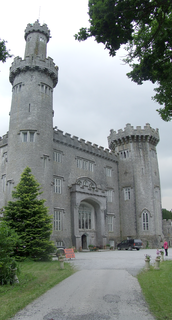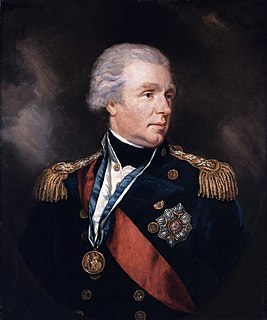 W
WEarl of Dunraven and Mount-Earl was a title in the Peerage of Ireland. It was created on 5 February 1822 for Valentine Quin, 1st Viscount Mount-Earl. Quin had already been created a Baronet, of Adare in County Limerick, in the Baronetage of Ireland, in 1781, Baron Adare, of Adare in the County of Limerick, on 31 July 1800, and Viscount Mount-Earl on 3 February 1816. He was made Viscount Adare in 1822 at the same time as he was given the earldom. The latter peerage titles were also in the Peerage of Ireland. The Quins were unusual among Irish landowning families in that era in being of Gaelic origin, although they married into Anglo-Irish families like the Widenhams of Kildimo and the Dawsons of Dublin.
 W
WBaron Ashtown, of Moate in the County of Galway, is a title in the Peerage of Ireland. It was created in 1800 for Frederick Trench, with remainder to the heirs male of his father.
 W
WEarl of Bandon was a title in the Peerage of Ireland. It was created in 1800 for Francis Bernard, 1st Viscount Bandon. He had already been created Baron Bandon, of Bandon Bridge in the County of Cork, in 1793, Viscount Bandon, of Bandon Bridge in the County of Cork, in 1795, and was made Viscount Bernard at the same time as he was granted the earldom. These titles were also in the Peerage of Ireland. The titles descended from father to son until the death of his great-grandson, James, the fourth Earl, in 1924. The late Earl was succeeded by his first cousin twice removed, Percy Bernard, the fifth Earl. The latter was the great-grandson of the Right Reverend Charles Bernard, Bishop of Tuam, younger son of the second Earl. the fifth Earl was an Air Chief Marshal in the Royal Air Force. He had two daughters but no sons and on his death in 1979 the titles became extinct.
 W
WEarl of Bantry, of Bantry in the County of Cork, was a title in the Peerage of Ireland. It was created in 1816 for Richard White, 1st Viscount Bantry, who had helped repelling the French invasion at Bantry Bay in 1797. He had already been created Baron Bantry, of Bantry in the County of Cork, and Viscount Bantry, of Bantry in the County of Cork, in 1800, and was made Viscount Berehaven at the same time he was given the earldom. These titles were also in the Peerage of Ireland. He was the grandson of Richard White, who had made an immense fortune through his work as a lawyer. Lord Bantry was succeeded by his son, the second Earl. He sat on the Conservative benches in the House of Lords as an Irish Representative Peer from 1854 to 1868. His younger brother, the third Earl, assumed in 1840 by Royal licence the additional surname of Hedges, which was that of his paternal grandmother. He was an Irish Representative Peer from 1869 to 1884. The titles became extinct on the death of his son, the fourth Earl, in 1891.
 W
WEarl of Bantry, of Bantry in the County of Cork, was a title in the Peerage of Ireland. It was created in 1816 for Richard White, 1st Viscount Bantry, who had helped repelling the French invasion at Bantry Bay in 1797. He had already been created Baron Bantry, of Bantry in the County of Cork, and Viscount Bantry, of Bantry in the County of Cork, in 1800, and was made Viscount Berehaven at the same time he was given the earldom. These titles were also in the Peerage of Ireland. He was the grandson of Richard White, who had made an immense fortune through his work as a lawyer. Lord Bantry was succeeded by his son, the second Earl. He sat on the Conservative benches in the House of Lords as an Irish Representative Peer from 1854 to 1868. His younger brother, the third Earl, assumed in 1840 by Royal licence the additional surname of Hedges, which was that of his paternal grandmother. He was an Irish Representative Peer from 1869 to 1884. The titles became extinct on the death of his son, the fourth Earl, in 1891.
 W
WEarl of Bandon was a title in the Peerage of Ireland. It was created in 1800 for Francis Bernard, 1st Viscount Bandon. He had already been created Baron Bandon, of Bandon Bridge in the County of Cork, in 1793, Viscount Bandon, of Bandon Bridge in the County of Cork, in 1795, and was made Viscount Bernard at the same time as he was granted the earldom. These titles were also in the Peerage of Ireland. The titles descended from father to son until the death of his great-grandson, James, the fourth Earl, in 1924. The late Earl was succeeded by his first cousin twice removed, Percy Bernard, the fifth Earl. The latter was the great-grandson of the Right Reverend Charles Bernard, Bishop of Tuam, younger son of the second Earl. the fifth Earl was an Air Chief Marshal in the Royal Air Force. He had two daughters but no sons and on his death in 1979 the titles became extinct.
 W
WViscount Bridport is a title that has been created twice, once in the Peerage of Great Britain and once in the Peerage of the United Kingdom. The first creation became extinct in 1814, while the second creation is still extant.
 W
WEarl Cadogan is a title that has been created twice in the Peerage of Great Britain for the Cadogan family. The second creation, in 1800, was for Charles Cadogan, 3rd Baron Cadogan.
 W
WEarl of Caledon, of Caledon in the County of Tyrone, is a title in the Peerage of Ireland. It was created in 1800 for James Alexander, 1st Viscount Caledon. He was a merchant who had made an enormous fortune in India. He also represented the constituency of Londonderry City in the Irish House of Commons. Alexander had already been created Baron Caledon in 1790 and Viscount Caledon, of Caledon in the County of Tyrone, in 1797, also in the Peerage of Ireland. In 1784, James Alexander purchased a city house in Dublin at Rutland Square where he lived when serving as an MP for Derry.
 W
WEarl Castle Stewart, in the County Tyrone, is a title in the Peerage of Ireland. It was created in 1800 for Andrew Thomas Stewart, 9th Baron Castle Stuart.
 W
WEarl of Charleville was a title that was created twice in the Peerage of Ireland. The first creation came in 1758 when Charles Moore, 2nd Baron Moore, was made Earl of Charleville, in the King's County. The title Baron Moore, of Tullamore in the King's County, was created in the Peerage of Ireland in 1715 for his father John Moore, who had previously represented King's County in the Irish House of Commons. Lord Charleville was childless and the titles became extinct on his death in 1764.
 W
WBaron Clanmorris, of Newbrook in the County of Mayo, is a title in the Peerage of Ireland. It was created on 6 August 1800 for John Bingham. He was a descendant of John Bingham of Foxford in County Mayo, whose brother Sir Henry Bingham, 1st Baronet, of Castlebar, was the ancestor of the Earls of Lucan. The first Baron's great-great-great-grandson, the seventh Baron, was a spy and crime novelist. As of 2010 the title is held by the latter's son, the eighth Baron, who succeeded in 1988.
 W
WEarl of Clanricarde is a title that has been created twice in the Peerage of Ireland, first in 1543 and again in 1800. The former creation became extinct in 1916 while the 1800 creation is extant and held by the Marquess of Sligo since 1916.
 W
WBaron de Blaquiere, of Ardkill in the County of Londonderry, was a title in the Peerage of Ireland. It was created on 30 July 1800 for the politician Sir John Blaquiere, 1st Baronet, Chief Secretary for Ireland between 1772 and 1777. He had already been created a Baronet, of Ardkill in the County of Londonderry, in the Baronetage of Ireland on 16 July 1784. He was the son of Jean de Blaquiere, a merchant who emigrated to England from France in 1685. Lord de Blaquiere was succeeded by his eldest son, the second Baron. He died unmarried and was succeeded by his younger brother, the third Baron. He was a general in the British Army. His two sons, John the fourth Baron and William Barnard the fifth Baron, both succeeded in the title. The latter was a Captain in the Royal Navy. He was succeeded by his first cousin once removed, the sixth Baron. He was the grandson of the Hon. Peter de Blaquière, fourth son of the first Baron. Lord de Blaquiere's two sons were both killed in the First World War and on his death in 1920 the titles became extinct.
 W
WEarl of Donoughmore is a title in the Peerage of Ireland. It is associated with the Hely-Hutchinson family. Paternally of Gaelic Irish descent with the original name of Ó hÉalaighthe, their ancestors had long lived in the County Cork area as allies of the Mac Cárthaigh clan; they lost out during the times of Oliver Cromwell. One branch of the family converted to the Anglican Church and after inheriting territories through his mother and adding "Hutchinson" to Hely, became the Earl of Donoughmore.
 W
WBaron Dufferin and Claneboye, of Ballyleidy and Killyleagh in County Down, Northern Ireland, is a title in the Peerage of Ireland. It was created 30 July 1800 for Dame Dorcas Blackwood, widow of Sir John Blackwood, 2nd Baronet, Member of the Irish Parliament for Killyleagh and Bangor, in return for support for the Union of Ireland and the United Kingdom.
 W
WBaron Dunalley, of Kilboy in the County of Tipperary, is a title in the Peerage of Ireland. It was created on 31 July 1800 for Henry Prittie, who had previously represented Banagher, Gowran and County Tipperary in the Irish House of Commons. His son, the second Baron, represented Carlow in the Irish Parliament and Okehampton in the British House of Commons and also sat in the House of Lords as an Irish Representative Peer from 1828 to 1854. He was succeeded by his nephew, the third Baron. When he died the barony was inherited by his son, the fourth Baron. He was an Irish Representative Peer between 1891 and 1927 and served as Lord Lieutenant of County Tipperary. As of 2014 the title is held by his great-grandson, the seventh Baron, who succeeded his father in 1992.
 W
WMarquess of Ely, of the County of Wexford, is a title in the Peerage of Ireland. It was created in 1800 for Charles Loftus, 1st Earl of Ely. He was born Charles Tottenham, the son of Sir John Tottenham, 1st Baronet, who had been created a baronet, of Tottenham Green in the County of Wexford, in the Baronetage of Ireland in 1780, by Elizabeth, daughter of Nicholas Loftus, 1st Viscount Loftus, sister and heiress of Henry Loftus, 1st Earl of Ely. In 1783 he succeeded to the Loftus estates on the death of his maternal uncle the Earl of Ely and assumed the same year by Royal licence the surname of Loftus in lieu of his patronymic. In 1785 he was raised to the Peerage of Ireland as Baron Loftus, of Loftus Hall in the County of Wexford. It was sold by the family in 1917 and is today owned by the Quigley family.
 W
WEarl of Listowel is a title in the Peerage of Ireland. It was created in 1822 for William Hare, 1st Viscount Ennismore and Listowel, who had earlier represented Cork City and Athy in the Irish House of Commons.
 W
WViscount Frankfort de Montmorency, of Galmoye in the County of Kilkenny, was a title in the Peerage of Ireland. It was created on 22 January 1816 for Lodge de Montmorency, 1st Baron Frankfort, who had earlier represented Bandon Bridge, Dingle, Inistioge and Ennis in the Irish House of Commons. He had already been made Baron Frankfort, of Galmoye in the County of Kilkenny, on 31 July 1800, also in the Peerage of Ireland. Born Lodge Evans Morres, he assumed in 1815 by Royal licence the surname of de Montmorency in lieu of Morres. However, the French House of de Montmorency never recognised his claim to be a member of that house. His grandson, the third Viscount, was a Major-General in the British Army and sat in the House of Lords as an Irish Representative Peer between 1900 and 1902. The latter's eldest son, the Honourable Raymond de Montmorency, was awarded the Victoria Cross for his actions at the Battle of Omdurman in 1898. He was killed in action in the Second Boer War two years later, predeceasing his father by two years. The third Viscount was succeeded by his second and only surviving son, the fourth Viscount. He was also a soldier. He died childless in 1917 when the titles became extinct.
 W
WBaron Gardner, of Uttoxeter, is a dormant title in the Peerage of Ireland. It was created in 1800 for Sir Alan Gardner, an Admiral of the Blue and former Member of Parliament for Plymouth and Westminster. In 1806, he was also created Baron Gardner, of Uttoxeter in the County of Stafford, in the Peerage of the United Kingdom. His son, the second Baron, was also an Admiral in the Royal Navy. In 1815, it was announced that he was to be created a viscount, but Lord Gardner died before the patent had passed the Great Seal.
 W
WSylvester Douglas, 1st Baron Glenbervie, PC, KC, FRS, FRSE, FSA was a British lawyer, politician and diarist. He was Chief Secretary for Ireland between 1793 and 1794.
 W
WMarquess of Headfort is a title in the Peerage of Ireland. It was created in 1800 for Thomas Taylour, 2nd Earl of Bective.
 W
WBaron Henniker, of Stratford-upon-Slaney in the County of Wicklow, is a title in the Peerage of Ireland. It was created in 1800 for Sir John Henniker, 2nd Baronet, who had previously represented Sudbury and Dover in the House of Commons. His son, the second Baron, also sat as a Member of Parliament. In 1792 he assumed by Royal licence the additional surname of Major. He was childless and was succeeded by his nephew, the third Baron. He assumed the additional surname of Major by Royal licence in 1822. His son, the fourth Baron, represented Suffolk East in Parliament. In 1866 he was created Baron Hartismere, of Hartismere in the County of Suffolk, in the Peerage of the United Kingdom. This title gave him and his descendants an automatic seat in the House of Lords. He was succeeded by his son, the fifth Baron. He also sat as Member of Parliament for Suffolk East and later held minor office in the Conservative administrations of Benjamin Disraeli and Lord Salisbury. His grandson, the eighth Baron, was a prominent diplomat and notably served as British Ambassador to Jordan and to Denmark. As of 2014 the titles are held by the latter's son, the ninth Baron, who succeeded in 2004.
 W
WViscount Kilwarden, of Kilwarden in the County of Kildare, was a title in the Peerage of Ireland. It was created on 29 December 1800 for Arthur Wolfe, 1st Baron Kilwarden, Lord Chief Justice of the King's Bench for Ireland. He had already been created Baron Kilwarden, of Newlands in the County of Dublin, on 3 July 1798, also in the Peerage of Ireland. Furthermore, his wife Anne, daughter of William Ruxton of Ardee, County Louth, by Mary, daughter of Samuel Gibbons, had in 1795 been raised to the Peerage of Ireland in honour of her husband as Lady Kilwarden, Baroness of Kilteel in the County of Kildare. Lord Kilwarden was killed in 1803 during the Irish Rebellion of 1803 where he was dragged from his carriage and piked to death.
 W
WBaron Langford, of Summerhill in the County of Meath, is a title in the Peerage of Ireland. It was created on 1 July 1800 for Clotworthy Rowley, who had earlier represented Trim and County Meath in the Irish House of Commons. Born Clotworthy Taylor, he was the fourth son of Thomas Taylor, 1st Earl of Bective and Jane Rowley, daughter of Hercules Langford Rowley and his wife Elizabeth Rowley, 1st Viscountess Langford. The viscountcy of Langford became extinct in 1796 on the death of Hercules Rowley, 2nd Viscount Langford. Clotworthy Taylor succeeded to the Rowley estates and assumed by Royal licence the surname of Rowley in lieu of Taylor. Four years later the Langford title was revived when he was raised to the Peerage of Ireland as Baron Langford.
 W
WEarl of Norbury, in the County of Tipperary, is a title in the Peerage of Ireland. It was created in 1827, along with the title Viscount Glandine, of Glandine in the King's County, for the Irish politician and judge John Toler, 1st Baron Norbury, upon his retirement as Chief Justice of the Common Pleas in Ireland. The titles were created with special remainder to his second son, Hector, as his eldest son, Daniel, was then considered mentally unwell. Lord Norbury had already been created Baron Norbury, of Ballycrenode in the County of Tipperary, in the Peerage of Ireland in 1800, with remainder to the heirs male of his body. Moreover, his wife, Grace Toler, had been created Baroness Norwood, of Knockalton in the County of Tipperary, in the Peerage of Ireland in 1797, with remainder to the heirs male of her body. By the time Lord Norbury was raised to the Earldom, his wife had died and their eldest son had succeeded her as 2nd Baron Norwood. This son also succeeded Lord Norbury himself on his death in 1831 as 2nd Baron Norbury, whilst his younger brother Daniel succeeded to the viscountcy and earldom according to the special remainder. In 1832, the second Earl also succeeded his elder brother in the two baronies. He had already in 1825 assumed the additional surname of Graham by Royal licence.
 W
WBaron Radstock, of Castletown in the Queen's County, was a title in the Peerage of Ireland. It was created in 1800 for Vice-Admiral the Honourable William Waldegrave. He was the second son of John Waldegrave, 3rd Earl Waldegrave. He was succeeded by his eldest son, the second Baron. He was a Vice-Admiral of the Red. On his death the title passed to his son, the third Baron. He is best remembered for his work as a missionary in Russia. Two of his sons, the fourth and fifth Barons, both succeeded in the title. The barony became extinct on the latter's death in 1953.
 W
WMarquess of Sligo is a title in the Peerage of Ireland. It was created in 1800 for John Browne, 3rd Earl of Altamont. The Marquess holds the subsidiary titles of Baron Mount Eagle, of Westport in the County of Mayo, Viscount Westport, of Westport in the County of Mayo, Earl of Altamont, in the County of Mayo, Earl of Clanricarde and Baron Monteagle, of Westport in the County of Mayo. All these titles are in the Peerage of Ireland, except the Barony of Monteagle, which is in the Peerage of the United Kingdom. The latter peerage entitled the Marquesses to a seat in the House of Lords prior to the House of Lords Act 1999. The Earldom of Clanricarde was inherited by the sixth Marquess in 1916 according to a special remainder in the letters patent.
 W
WEarl of Normanton is a title in the Peerage of Ireland. It was created in 1806 for Charles Agar, 1st Viscount Somerton, Archbishop of Dublin. He had already been created Baron Somerton, of Somerton in the County of Kilkenny, in 1795 and Viscount Somerton, of Somerton in the County of Kilkenny, in 1800, also in the Peerage of Ireland. Lord Normanton sat in the House of Lords from 1800 to 1809 as one of the 28 original Irish Representative Peers.
 W
WEarl Cadogan is a title that has been created twice in the Peerage of Great Britain for the Cadogan family. The second creation, in 1800, was for Charles Cadogan, 3rd Baron Cadogan.